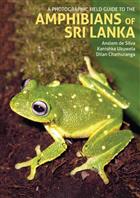A Photographic Field Guide to the Amphibians of Sri Lanka
- Series : Photographic Field Guide
- Publisher : John Beaufoy Publishing
- Illustrations : c.400 photos, col distribution maps
Our customers have given this title an average rating of 5 out of 5 from 1 review(s)
Customer Rating: 




Description:
A Photographic Field Guide to the Amphibians of Sri Lanka is a complete guide to the 120 species of frog, toad and caecilian found in Sri Lanka. Extinct species are also listed for completeness. With photographs from the authors, each species is illustrated with many variants.The general introduction includes details of the climate, geography and vegetation of the island, key characteristics that can be used in the identification of amphibians, information on amphibian conservation in Sri Lanka, a brief introduction to folklore and where to look for amphibians.
The species descriptions include the common English name, the current scientific name, the vernacular name in Sinhala, a brief history of the species, a description with identification features, and details of habitat, habits and distribution (in Sri Lanka and outside the country). Key external identification features, such as body form, skin texture and colouration, are provided, to help in the identification of an animal in the field.
Customer Reviews
Our customers have given this title an average rating of 5 out of 5 from 1 review(s), Click here to add your own review for this title.
Gehan de Silva Wijeyeratne on 8/25/2023 10:00:30 PM




 (5 out of 5)
(5 out of 5)
This is an important milestone in the Sri Lankan natural history field guide literature as it is the first comprehensive field guide in English to the country's 102 extant species of amphibians. What I especially like about this book is that it is a thoroughly modern field guide.
The book begins with a topographic map of Sri Lanka overlaid with key roads and nature reserves followed by a geo-climatic map in the front section pages. All field guides should have these. The front sections run into 35 pages and include both a general introduction to amphibians as well as one specific to Sri Lankan amphibians. Topics covered include climatic zones and habitats, identification, conservation, folklore, a glossary and practical tips on finding amphibians. The reader is advised to turn stones or logs towards oneself, counterintuitive as it may seem, this offers protection from concealed snakes that may strike. The end sections include a checklist and references.
The bulk of the book (pages 35 to 232) is taken by the species descriptions covering the two scientific orders of amphibians. The order Anura (Frogs and Toads) is represented by 5 families. The Bufonidae (Toads, 6 species), Dicroglossidae (Fork-tongued Frogs, 13 species), Microhylidae (Narrow-mouth Frogs, 12 species), Ranidae (True Frogs, 3 species) and Rhacophoridae (Afro-Asian Tree Frogs, 83 species). The order Gymnophiona is represented by one family the Icthyophiidae, the Asiatic-tailed Caecilians. The radiation of the Rhacophorids, 83 species, in Sri Lanka is one of the most remarkable examples of island radiations in the scientific literature. Furthermore, 89 per cent of all amphibians are endemic to Sri Lanka. The country is an amphibian hot spot.
The species accounts are well structured with the species name given in Sinhala, one of the two local languages. I suspect a Tamil nomenclature of common names is a pending task. The first part of the species account explain when and by whom a species was first described followed by the changes in the Latin name. This typically indicates changes to its generic placement, sometimes involving multiple changes. Although there are many online databases that track the historical taxonomy, it is useful to have this on the page. Size is given followed by the section on Identification Features. This is usually the most extensive part of the text and well written as it focusses on key ID characters and how to tell apart similar species. This is supported by the good photographs some of which have arrows pointing out key characters. This is the first time a comprehensive amphibian guide in English has drawn out succinctly key identification characters for field use. Some amphibian species will require examination in the hand. Other standard sections in the text includes Colour, Habits, Habitat and Distribution, Status (e.g. if endemic) and IUCN Red List Category. There are maps for each species account indicating where a species has been recorded. Sometimes there may be as little as one dot, or just two or three dots. Single dots may not necessarily be due to a lack of field work. But can often indicate that a species is a point endemic which is confined to one mountain peak or valley. This highlights the risk that with forest clearance Sri Lanka may have lost species before science even caught up with them.
I will conclude by saying, on the whole this field guide is a fantastic piece of work, especially for a first edition. A Photographic Filed Guide to the Amphibians of Sri Lanka will be a game changer and open up amphibian identification to a wider range of serious natural history enthusiasts who previously would have found it too difficult to attempt as there was too much of a mass of seemingly dense and impenetrable scientific literature. This book will also make it easier for those who conduct ecological surveys and environmental impact assessments to more easily compile an accurate inventory of species at a site and to assess threats to amphibians. After all for the eyes to see, we first need to have a name, and to be able to tell apart one named species from another. This book will accelerate the discovery and description of new species.
You may also like...
Handbook of Amphibians and Reptiles of Northeast Africa
Spawls, S.; Mohammad, A.; Mazuch, T.
Price £68.00
(Save £17.00)












